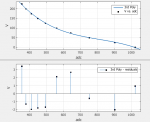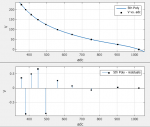retepsnikrep
Senior Member
Another maths question.
I have an adc connected to a HV supply via a non linear isolation circuit.
It produces the below 10bit ADC readings at the given input voltage.
That works fine but i want to create a formula from these data points to allow the adc to produce the actual voltage.
I don't want to use a lookup table if possible.
Accuracy to 1V is acceptable. There should be enough adc resolution to do that with the right formula.
225v = 356
200v = 380
175v = 412
150v = 450
125v = 495
100v = 561
75v = 644
50v = 753
25v = 903
10v = 1000
5v = 1020
0v = 1023
How to convert that data into some sort of forumla to produce the voltage from a given adc reading.
I'm sure I've seen something like this done on excel?
Produce a graph from the data and then it creates a formula? Sorry i'm no excel expert.
It's not linear.
Thanks
I have an adc connected to a HV supply via a non linear isolation circuit.
It produces the below 10bit ADC readings at the given input voltage.
That works fine but i want to create a formula from these data points to allow the adc to produce the actual voltage.
I don't want to use a lookup table if possible.
Accuracy to 1V is acceptable. There should be enough adc resolution to do that with the right formula.
225v = 356
200v = 380
175v = 412
150v = 450
125v = 495
100v = 561
75v = 644
50v = 753
25v = 903
10v = 1000
5v = 1020
0v = 1023
How to convert that data into some sort of forumla to produce the voltage from a given adc reading.
I'm sure I've seen something like this done on excel?
Produce a graph from the data and then it creates a formula? Sorry i'm no excel expert.
It's not linear.
Thanks






